
Nudibranchs belong to the order Nudibranchia, a group of soft-bodied marine gastropod molluscs that shed their shells after their larval stage. They are noted for their often extraordinary colours and striking forms, and they have been given colourful nicknames to match, such as "clown", "marigold", "splendid", "dancer", "dragon", and "sea rabbit". Currently, about 3,000 valid species of nudibranchs are known.

The California sea hare is a species of sea slug in the sea hare family, Aplysiidae. It is found in the Pacific Ocean, off the coast of California in the United States and northwestern Mexico.

Sea slug is a common name for some marine invertebrates with varying levels of resemblance to terrestrial slugs. Most creatures known as sea slugs are gastropods, i.e. they are sea snails that, over evolutionary time, have either entirely lost their shells or have seemingly lost their shells due to having a significantly reduced or internal shell. The name "sea slug" is often applied to nudibranchs and a paraphyletic set of other marine gastropods without apparent shells.

Opisthobranchs is a now informal name for a large and diverse group of specialized complex gastropods which used to be united in the subclass Opisthobranchia. That taxon is no longer considered to represent a monophyletic grouping.

Glaucus atlanticus is a species of sea slug in the family Glaucidae.

Aeolidia papillosa, known as the common grey sea slug, is a species of nudibranch in the family Aeolidiidae.

Doto amyra, or the hammerhead doto, is a species of very small or minute sea slug, a nudibranch, a shell-less marine gastropod mollusk in the family Dotidae.
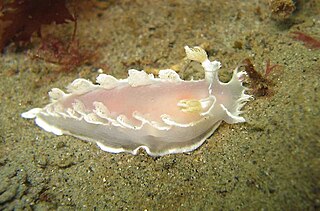
The diamondback tritonia is a species of nudibranch, a marine gastropod mollusk in the family Tritoniidae. It is an opportunistic predator of other marine invertebrates.

Rostanga pulchra is a species of sea slug, a dorid nudibranch, a shell-less marine gastropod mollusk in the family Discodorididae.
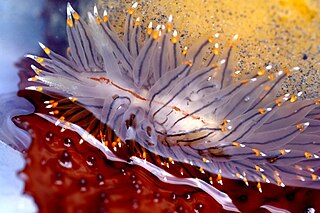
Janolus fuscus is a species of sea slug, or more accurately a nudibranch, a marine gastropod mollusc in the family Janolidae.

The alabaster nudibranch, white-lined Dirona, or frosted sea slug is an Eastern Pacific Ocean opisthobranch gastropod mollusk in the family Dironidae.
The sensory organs of gastropods include olfactory organs, eyes, statocysts and mechanoreceptors. Gastropods have no sense of hearing.
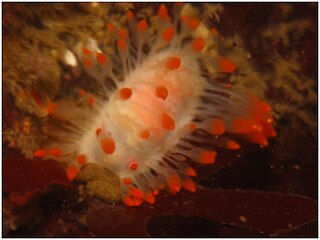
Limacia cockerelli is a species of sea slug, a dorid nudibranch, a shell-less marine gastropod mollusc in the family Polyceridae.

Hopkin's rose nudibranch is a species of sea slug, specifically a dorid nudibranch, a marine gastropod mollusc in the family Goniodorididae. Previously known as Okenia rosacea, this species was reclassified as Ceratodoris rosacea in 2024.
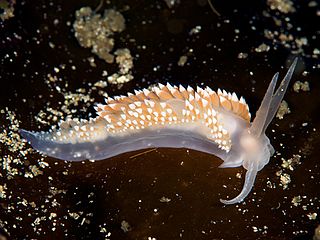
Coryphella verrucosa, is a species of sea slug, an aeolid nudibranch, a marine gastropod mollusc in the family Coryphellidae.

Doto kya is a species of sea slug, a nudibranch, a marine gastropod mollusc in the family Dotidae.
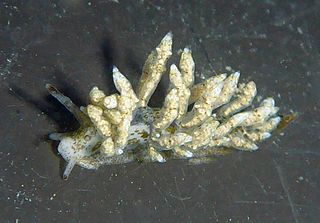
Eubranchus rustyus, the homely aeolid, is a species of sea slug or nudibranch, a marine gastropod mollusc in the family Eubranchidae.

Aeolidia loui is a species of sea slugs, an aeolid nudibranch, a marine gastropod mollusc in the family Aeolidiidae. It has been regarded as the same species as the NE Atlantic Aeolidia papillosa but is now known to be a distinct species. Common names include shaggy mouse nudibranch, and shag-rug nudibranch.

Phestilla minor is a species of sea slug in the Trichechidae family. It is a type of aeolid nudibranch under the Aeolidina suborder. Phestilla minor is a benthic sea slug that is a very small, slow-moving organism found in marine habitats all over the world.
Janolus flavoanulatus is a sea slug species. The specific name is derived from Latin words flavus (“yellow”) and anulatus (“ringed”). These soft-bodied mollusks are known for their extraordinary colors and prominent forms. The first description of this species was reported by researcher Terry Gosliner, a leading researcher in the evolutionary history of nudibranchs. Upon his conducted research in the Philippines, Gosliner named Janolus flavoanulatus for its yellow ring around its cerata.



















